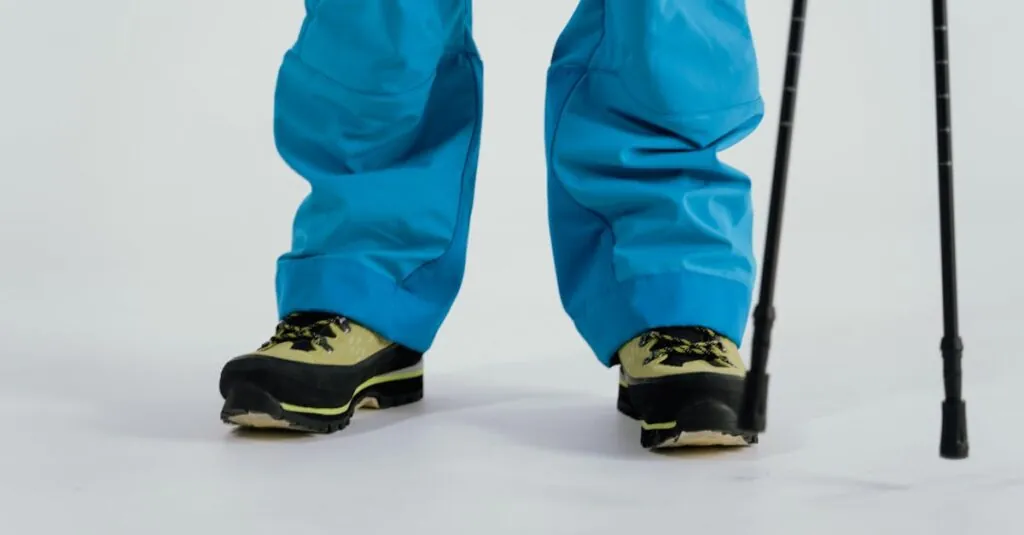Table of Contents
ToggleHiking can feel like a walk in the park—until it isn’t. Enter adjustable hiking poles, the unsung heroes of the trail. These nifty gadgets don’t just keep you from face-planting into the dirt; they can transform your hiking experience from “why did I sign up for this?” to “I could conquer Everest!” With the ability to customize their height, they adapt to any terrain and any hiker, whether you’re scaling rocky peaks or strolling through serene forests.
Imagine gliding effortlessly over obstacles while your friends struggle with their flimsy sticks. Adjustable hiking poles offer stability, reduce strain on your knees, and give you that extra boost when you need it most. Plus, they’re lightweight and easy to pack, so you can focus on enjoying the view instead of worrying about your next trip to the chiropractor. So why not level up your hiking game?
What Are Adjustable Hiking Poles?
Adjustable hiking poles are versatile tools used to assist hikers on various terrains. They typically consist of telescoping shafts that can be shortened or lengthened to accommodate the user’s height and preferences. Many poles feature quick-lock mechanisms, allowing for easy adjustments even during a hike.
Durability is a key aspect of adjustable hiking poles. Most models use lightweight materials such as aluminum or carbon fiber, providing strength without adding excessive weight. This construction ensures they withstand rugged conditions while maintaining maneuverability.
Comfort plays an essential role in design. Adjustable hiking poles often incorporate padded grips and adjustable wrist straps to enhance user experience. These features reduce fatigue and ensure a stable grip, even on long hikes.
The versatility of these poles makes them suitable for various activities. Hikers, backpackers, and trekkers utilize adjustable hiking poles alongside outdoor enthusiasts who engage in snowshoeing or cross-country skiing. Their adaptability ensures effectiveness across different environments.
Many people find that using adjustable hiking poles improves their overall hiking experience. By providing stability and support, these poles minimize the impact on joints, particularly during descents. Terrain variations also become more manageable, allowing users to navigate obstacles with confidence.
Adjustable hiking poles represent an essential gear for numerous outdoor activities. Their adjustable features cater to individual needs, while their ergonomic designs enhance comfort and functionality.
Benefits of Using Adjustable Hiking Poles
Adjustable hiking poles offer multiple advantages that enhance the outdoor experience. Hikers benefit from improved safety, comfort, and performance while navigating various trails.
Improved Stability and Balance
Enhanced stability becomes evident when using adjustable hiking poles. These poles provide crucial support on uneven terrain, preventing slips and falls. Hikers feel more secure while traversing rocky paths or steep inclines. Adjustable lengths accommodate different body types, allowing each individual to find their ideal height for optimal balance. The distribution of weight shifts effectively, stabilizing movements and reducing the risk of injuries. Users report greater confidence while tackling challenging sections of trails, making the overall hike more enjoyable.
Reduced Strain on Joints
Reducing strain on joints significantly enhances the hiking experience. Adjustable hiking poles absorb shock, decreasing stress on knees and ankles during descents. Hikers experience less fatigue due to the poles sharing their body weight and maintaining proper posture. Adaptive lengths allow users to find a comfortable position that promotes better mechanics and minimizes discomfort. Many find that incorporating adjustable hiking poles leads to fewer aches and pains after long excursions. This relief allows outdoor enthusiasts to enjoy more time exploring nature without the burden of joint strain.
Key Features to Consider
When selecting adjustable hiking poles, several key features significantly affect performance and comfort. Understanding these aspects ensures the best choice for all hiking enthusiasts.
Material and Durability
Lightweight aluminum and carbon fiber represent the most common materials used for hiking poles. These materials offer robust durability while minimizing overall weight. Aluminum poles tend to be more affordable and resistant to dents. Carbon fiber poles exhibit superior shock absorption and stiffness, ideal for long treks. Hikers benefit from materials that withstand various weather conditions and rugged terrains. A combination of material properties impacts longevity and overall user satisfaction.
Locking Mechanisms
Reliable locking mechanisms play a vital role in pole performance. Twist locks and lever locks are the two primary options available. Twist locks allow for quick adjustments and secure placement but may require more maintenance over time. Lever locks feature a quick-release function that ensures easy height modification during hikes. Stability and security during use are paramount, as subpar locks can cause accidents or discomfort. A dependable locking system guarantees that poles remain at the desired length throughout different activities.
Weight and Portability
Lightweight poles enhance portability and ease of use. Many hiking poles weigh between 0.5 and 1.5 pounds, striking a balance between sturdiness and manageability. Less weight reduces fatigue, allowing for longer hikes without excessive strain. Compact folding designs also facilitate easy storage in backpacks when not in use. Portability becomes particularly crucial for multi-day hikes with limited space. Selecting lightweight options ensures efficiency and comfort during outdoor adventures.
Top Adjustable Hiking Poles on the Market
Numerous adjustable hiking poles are available, each designed to elevate the hiking experience. Below are some top options currently popular among outdoor enthusiasts.
Product Reviews
Black Diamond Trail Pro Shock features a shock-absorbing mechanism that minimizes impact on joints. It boasts durable aluminum construction, ensuring reliability for rugged terrains. Adjustable length allows for a custom fit, catering to various user heights. Lightweight design makes carrying easy on long treks. LEKI Micro Vario Ti stands out for its impressive carbon fiber build, providing excellent shock absorption. Its SpeedLock 2 adjustment system secures height with minimal effort. Padded grips and wrist straps enhance comfort during extended use.
Price Comparison
Prices for adjustable hiking poles can vary based on materials and brand reputation. Black Diamond Trail Pro Shock typically retails around $159.95, reflecting its durable design and advanced features. In contrast, LEKI Micro Vario Ti starts at approximately $199.95, justified by the premium carbon fiber construction and lightweight performance. Budget-friendly options are also available, such as Trekology Trekking Poles priced around $49.99, making quality hiking poles accessible for casual hikers. Evaluating these prices helps consumers make informed choices aligned with their hiking needs and budget.
Adjustable hiking poles are a game changer for outdoor enthusiasts. They not only enhance stability and reduce strain but also adapt to various terrains and individual preferences. With the right poles, hikers can tackle challenging trails with confidence and comfort.
Investing in quality adjustable hiking poles can significantly improve the overall hiking experience. From lightweight materials to ergonomic designs, these poles offer essential support for both novice and experienced hikers alike. By choosing the right features and options, anyone can elevate their adventures while enjoying the great outdoors.







